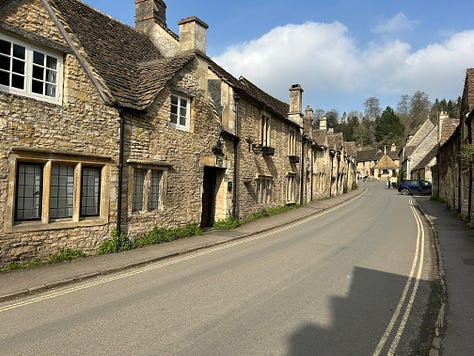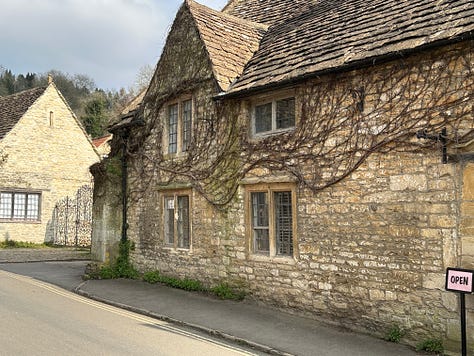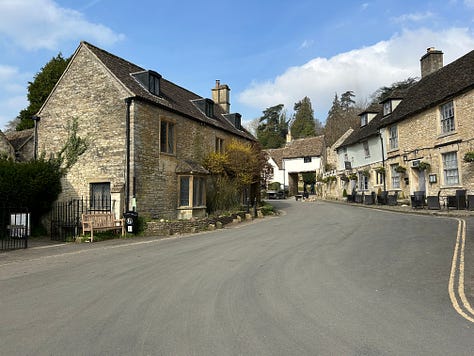The village of Castle Combe
Castle Combe lies at the southern end of The Cotswolds, a designated area of natural beauty. This village, in the county of Wiltshire, is a time capsule. There have been no houses built in the centre of the village since the 1600s.
Set in a valley (combe) and once having a castle gives rise to the name, Castle Combe. I park my car in the official village car park off Dunns Lane in Upper Castle Combe. The village has an Upper and Lower part. The Upper part includes Castle Combe Motor Racing Circuit, built upon a former WW2 airfield, and has a greater mix of newer properties.
I set off from the car park down the hill into the village. It’s quite an incline and those less able should be careful and might need dropping off in the village whilst the driver parks. There is limited parking close to the village unless you stay at The Manor House Hotel which currently starts from £250 per night for bed and breakfast. They also have self-catering cottages and rooms at The Castle Inn. All very nice.
Until 2011 the village had a museum and I pass this on the right as I walk down the hill. You can’t miss it as it is called The Old Museum. The contents of the museum are in storage and hopefully one day a place can be found for them to be displayed. Before it closed, I was fortunate to be able to visit.
The buildings are all built from beautiful Cotswold stone and are ageing beautifully. This stone really does stand the test of time and without city levels of traffic pollution has a lovely colour.
In the centre of Castle Combe is the covered market cross. This is late medieval (14th century) and would have been bustling on market days. In England, a market had to be granted to a village by Royal Decree. This was granted by King Henry VI in 1440. The market cross shows that the village was once a thriving commercial centre. Prosperity was created because of the woollen industry. A red and white cloth referred to as ‘Castlecombe’ was produced and sold in the markets of Bristol, Cirencester, and London. It was also exported abroad.

The River Bybrook flows through the village and in the opening photo you can see it. Interestingly, the river bank in front of the cottages was used as the quayside for the 1967 film starring Rex Harrison, Dr Dolittle. This very river produced the power for milling the wool but for some reason, the level fell and sent the woollen industry into decline. Without the woollen mill, there would be very few cottages in the village as they were built to house the many workers required to service this industry.
I love clocks, amongst other mechanical things, and the church has something very interesting for visitors to see. St Andrew’s Church has a faceless clock. This clock is most likely to have been constructed in the 15th century. Construction of the tower it was made for was during the 15th century. After 1670 the clock was converted to a pendulum movement. It was originally placed high in the tower until 1984 when it was brought to the ground floor and mounted on a concrete plinth. The shortened length the weight has to travel is now ‘rewound’ using an electric motor which is enclosed in the wooden box inside the cabinet. Before it was moved required someone to haul the stone back up the tower to provide the clock’s power.
The church originates from the 13th century. Today, part of the chancel is 13th-century but during 1850–51 nearly all of the church, except the 15th-century tower, was taken down and reconstructed to the same plan. Such rebuilding and renovation of churches in that period is very common in England.
The purpose of the clock is to tell the time by the striking of the bell. A semi-circular white dial has been fitted so that the time is displayed for adjustment purposes and a single clock hand turns anti-clockwise.
The church is open for visitors to take a tour and you can download a guide to your phone and follow the route. Scan the 2 QR codes upon entry as this is an offline system and follow the route, just like the clock, anti-clockwise. The history of the village is explained on storyboards.
The village has two pubs, The Castle Inn and opposite is the White Hart which was partially covered by scaffold on my visit. No wonder maintenance is required when you think that the White Hart dates back to the 14th century and the Castle Inn has parts going back to the 13th century. That’s back to the very early days of this 12th-century village.
Click on photos to enlarge.


The village, thankfully, has not been overly commercialised. You can obtain refreshments at The Old Stables in the Estate Yard, the Little Picnic Shop for takeaways, and The Old Rectory offers a private dining experience. These are in addition to the two pubs and The Manor House.
The village has several recommended circular walks that you can do. These will enhance your visit and let you see more of the countryside. Here’s a link if you wish to do those walks.









For those of you who are wondering where the castle is. Let me explain. The castle was built on higher ground during the 12th century. It eventually, like many castles, became disused and no doubt much of the stone was recycled into many houses in the area. The site of the castle is part of Castle Combe Golf Course and is therefore on private land. It is heavily overgrown and all that remains is a mound and the odd piece of stonework.
If you would like to watch a video of my trip to Castle Combe you can view it on YouTube.
Thank you for reading and if you’re not a subscriber yet, please do become one.







Thank you Angeline. I only discovered that Henry Shrapnel was born at Midway Manor a while ago and prompted me to write about him. I hadn’t connected the Castle Combe link, so thank you for taking the time to comment. There is so much history in this area!
Fascinating video, thank you. I have a strong 'pull' to Wiltshire, Bradford-on-Avon in particular but also to Castlecombe, one of my ancestors was Lady Helena Scrope who married a Shrapnel from B-o-A. The Scrope coat of arms has a degree of celebrity in heraldry, known as the Scrope/Grosvenor Controversy. The Scropes won the case though the Grosvenors seemed to prosper more! I visited the village in the '60s but haven't had an opportunity to return, you've whetted my appetite to perhaps go back there before I'm too ancient. From memory some of the tiles in the chancel of the church are the coat of arms, very simple, just a shield azure with a bar or.